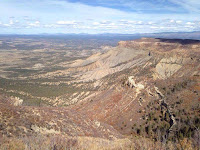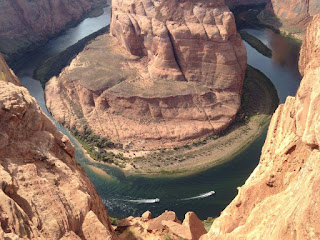The road leading to Zion National Park was also quite pretty and as had been everywhere out this way, the road was well signed to watch for deer. Only this time, you didn’t have to wonder if there were actually any deer around as everywhere you looked, there was a deer on the side of the road. As the sun began to set, more and more deer kept popping up.
Entranced and wary of the deer, we then missed our turn off to Zion Ponderosa Ranch. Once again getting lost led us to another cool animal sighting. A ranch full of bison! Unfortunately they were a little far away to photograph, so we got back to our turn off and headed for the ranch.
Well, we thought there were a lot of deer on the previous road. HA! That was nothing compared to this road. Along the road were mostly fields of long grass, ranches and accommodation. Naturally, the long grass attracted the deer. Hundreds of deer. It was quite an incredible and daunting sight. While we couldn’t help but enjoy the fields full of deer, we also kept wondering when one was going to leap out in front of the car. Thankfully though, we made it to Zion Ponderosa Ranch, just as the sun had set.
After checking in, we were then sent on our way to our accommodation. Zion Ponderosa is a huge place, with cabins, R.V sites, hotel style accommodation, camp sites, and our accommodation. An old school wagon. It was literally a wild west wagon, decked out with a double and two single beds and although it had no electricity, it was a super cool place to be spending a few nights.
The first morning at the ranch we decided to make the 90minute drive to Bryce Canyon. On the way there we stopped off at a Red Canyon National Park, where we climbed a steep little hill made entirely of fire red rocks. It was beautiful and a nice little warm up for what was to come in Bryce Canyon.
After the scenic drive into Bryce, we eventually made it to our first stop. Sunrise view point. Originally we were just going to stop here and look at the breathtaking views. So we walked over to Sunset Point to check it out and decided that while we were there, we may as well walk the Queens Garden trail.
It was spectacular, with crazy rock formations in many shades of reds, orange and white which were caused by the different chemicals in the sandstone rocks. It was also known as The Queens Garden as one of the formations looked like the Queen sitting on her throne overlooking her gigantic garden.
From Queens Garden, we decided to keep on going and ended up walking the Navajo loop. The views and crazy formations continued. We also got to walk through a bit of a pine forest, which allowed us to see a beautiful bluebird and see the canyon from a different perspective.
 |
| The Queen on her throne is the spire on the left |
The last little part of the hike was indeed the most strenuous. It was a zigzag up the side of the canyon. It also had a really cool rock formation along the way, known as Thor’s Hammer. Clearly, a few people were not prepared for the exertion that the trek provided, as there were many stopped, huffing and puffing. However, we eventually made it to the top and once more the views from up high took our breath away.
Once we had finished the 5.2km hike, we decided we wouldn’t have time to do the intended 7km hike we had planned on and make it back to Ponderosa before the deer came out to ‘play’. So instead we drove around to a couple more of the viewpoints.
These included Rainbow point (the highest point at 9115ft), Ponderosa and Bryce viewpoints. All of which provided a slightly different perspective, a hell of a lot of wind and spectacular views. On our way out of the national park we again spotted a few deer as we eventually made it back to the ranch for the evening.
Once again as we had done the previous evening, we made our way to the restaurant at the ranch. Just as the night before, we had a half hour wait for a table. However, it was worth the wait. The food was pretty delicious at Ponderosa and after a full day of hiking and exploring, the large meals were certainly appreciated!
 |
| Thor's Hammer |
As we drove into the park, soaking in some of the most incredible views yet, we suddenly noticed how many cars were parked along the edges. Then we arrived at a checkpoint where cars and R.Vs took turns of crossing through a tunnel bridge. We must have waited twenty or so minutes before we got through. Then on the other side, we again could not believe the views we were seeing, likewise, we could not believe the line of cars zigzagging down into the national park.
Continuing on through the park, each and every carpark was taken. So we kept on going and before we realised, we were out the other side of the National Park! We eventually found a paid parking spot and got ourselves in line for the shuttle back into the park. We realised it was probably going to be the last nice weekend before the cold weather hit, so every man, woman and child had decided to visit the park. So not only did it cost us an extra $20 US for parking, on top of our park entry fee, but we had now lost about 2.5 hours, making it 11:30am before we even got to Angels Landing starting point.
 |
| The peak we are about to climb |
Putting the park and ride saga aside, we prepared ourselves for what is known as one of the most treacherous hikes in the USA. We had learned, not too long before starting, that 6 people had died doing this exact hike since 2006. So we were a little nervous, but totally excited to get going.
With the adrenaline coursing through us, we began the small but steep 4.35km accent. The first section although windy and relatively steep, was pretty tame. The views, however, were already breathtaking. So after hiking for only about an hour, we had reached the first stopping point. A point high enough, that some spectacular views of the hills and valleys around us could be seen. It was also the point where people had to decide to proceed to the summit, or turn back. Just by looking ahead, it was clear not too many people chickened out and turned back. The trail was packed and there was only one way up and one way down, so it was pretty chaotic!
 |
| Half way up |
There were also many moments where you had to pause to let the people coming the opposite direction pass. Often there was scarcely enough space for one to hold on, let alone two. Unfortunately there were also many impatient people trying to overtake the slower ones. It was frustrating to say the least.
For the most part though, it was exceptionally beautiful and fun and sure enough, after about a 45 minute climb/scramble/battle, we had reached the very top. So had a million other people. The views though, oh the views. They were just incredible and so worth the hike.
Once we had eaten our lunch and appreciated the views, it was time for the descent. Again it took us about 45 minutes just to climb down to the first rest point, due to the sheer volume of people. Then from that point on it took us only about another 30 minutes to get back to the trailhead. It was a quick descent due to the steepness and it was just easier to run down most of the way.
When we got back to the shuttle stop, we were naturally exhausted. However, the sense of satisfaction and achievement outweighed the pain. As did the memories we will forever have of the climb and the views.
Not too long after, the shuttle bus arrived and we made our way back to the visitor information centre. Here we got a coffee and worked out our plan for the next day. To do The Narrows or to not do The Narrows.
After another hearty meal and an early night, we arose again quite early and made our way back to Zion National Park for round two. After much deliberation, we had decided to forgo The Narrows as it was quite simply the wrong time of year and way too cold! So after making our way once again though the park and to the other side, where we found some free parking, we hopped aboard the shuttle at the Visitor Information Centre and made our way back into the park. This time we made our way to The Hidden Canyon trailhead.
This hike was again a little tricky in places, requiring hikers to once again walk a narrow cliff edge, while holding onto a link chain. However, it was beautiful. It lead us to a couple of viewpoints which overlooked, as the name would suggest, a hidden canyon. Where rescue workers were honing their repelling and rescue skills.
As this hike was only a 3.9km round trip, we decided to forge on up the other side of the track and do the beginnings of the East Rim trail, which leads to Observation Point. We probably hiked about the first 2km of the 12.9km trail, to a beautiful panoramic point which provided sweeping views of Zion and back over to Angels Landing. Along the way, we ran into people who had almost completed the 12.9km hike and they raved about the views. Sadly though, we did not have time and we were very sore and tired from the day before. So after some time just sitting and enjoying the views, we made our way back to the shuttle stop.
 |
| The trail up to the hidden canyon |
When we arrived back at the visitor centre, we decided this time to head to the pub for a celebratory beer and some well earned chicken wings. Not only were both thoroughly enjoyable, but there were also still views of the surrounding mountains to enjoy. So enjoy we did!
For our last night at Zion Ponderosa Ranch, we had a few beers, enjoyed another hearty meal and crawled oh so thankfully into our wagon for a solid nights sleep. We absolutely loved our time at Bryce and Zion (despite the crowds) and the next morning we were on our way back to Las Vegas.
Holly.





























































